
The black-and-white shrike-flycatcher, also known as the black-and-white flycatcher or vanga flycatcher, is a species of passerine bird found in Africa. It was placed with the wattle-eyes and batises in the family Platysteiridae but is now considered to be more closely related to the helmetshrikes and woodshrikes.

Bower's shrikethrush, also known as the stripe-breasted shrike-thrush, is a species of bird in the family Pachycephalidae. It is endemic to Australia. It is found on the southeast coast of Cape York Peninsula.

The Caribbean elaenia is a species of bird in the family Tyrannidae found in the West Indies and parts of Central America. Its natural habitats are tropical and subtropical dry broadleaf forest, subtropical or tropical moist lowland forest, and heavily degraded former forest.

The highland elaenia is a species of bird in the family Tyrannidae, the tyrant flycatchers. It is found in southeastern Ecuador to Bolivia and northwestern Argentina

The Burmese shrike is a species of bird in the family Laniidae. It is found in Bangladesh, Cambodia, China, India, Laos, Myanmar, Thailand, and Vietnam. Its natural habitats are subtropical or tropical moist lowland forest and subtropical or tropical moist montane forest.

The African shrike-flycatcher or red-eyed shrike-flycatcher is a species of bird in the family Vangidae. It is monotypic within the genus Megabyas. It is found in Angola, Benin, Cameroon, Central African Republic, Republic of the Congo, Democratic Republic of the Congo, Ivory Coast, Equatorial Guinea, Gabon, Gambia, Ghana, Guinea, Kenya, Liberia, Mali, Nigeria, Sierra Leone, South Sudan, Tanzania, Togo, Uganda, and Zambia. Its natural habitats are subtropical or tropical dry forests and subtropical or tropical moist lowland forests.

The white-streaked friarbird is a species of bird in the family Meliphagidae. It is monotypic within the genus Melitograis. It is endemic to Northern Maluku in Indonesia. Its natural habitats are subtropical or tropical moist lowland forests, subtropical or tropical mangrove forests, and subtropical or tropical moist montane forests.
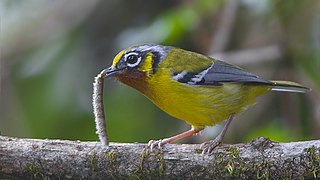
The black-eared shrike-babbler is a bird species in the vireo family, Vireonidae. It was traditionally considered as an aberrant Old World babbler and formerly placed in the family Timaliidae. It was long noted that their habits resembled those of vireos, but this was previously ascribed to the result of convergent evolution. It is found in Southeast Asia from the Himalayas to western Malaysia. Its natural habitat is subtropical or tropical moist montane forests.

The black-headed shrike-babbler is a bird species traditionally placed with the Old World babblers in the family Timaliidae. However, it might be one of the few Eurasian vireos (Vireonidae).

The green shrike-babbler is a bird species that was earlier placed in the family Timaliidae. The species is now considered to be an Asian offshoot of the American vireos and belongs in the family Vireonidae.

The white-throated thrush is a species of bird in the family Turdidae. It is found in Mexico and Central America, ranging south to central Panama. This species has been referred to in some literature as "white-throated robin." However, that name is now more usually applied to the Old World species Irania gutturalis.
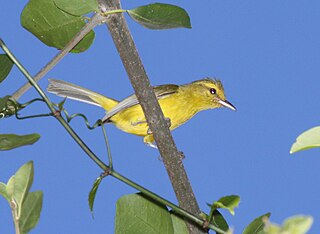
The golden vireo is a species of bird in the family Vireonidae. It is endemic to Mexico. Its natural habitats are subtropical or tropical dry forests and subtropical or tropical moist lowland forests.

The Yucatan vireo is a species of bird in the family Vireonidae.

The Jamaican vireo is a species of bird in the family Vireonidae. It is endemic to Jamaica. Its natural habitats are subtropical or tropical dry forest, subtropical or tropical moist lowland forest, subtropical or tropical moist montane forest, and heavily degraded former forest.
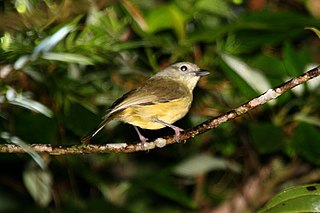
The Blue Mountain vireo is a species of bird in the family Vireonidae. It is endemic to Jamaica. Its natural habitats are subtropical or tropical moist lowland forests, subtropical or tropical moist montane forests, plantations, and heavily degraded former forest. It is threatened by habitat loss.
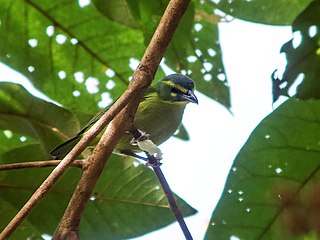
The yellow-browed shrike-vireo is a species of bird in the family Vireonidae.

The slaty-capped shrike-vireo is a species of bird in the family Vireonidae. It is found in Bolivia, Brazil, Colombia, Ecuador, French Guiana, Guyana, Peru, Suriname, and Venezuela. Its natural habitats are subtropical or tropical moist lowland forests and subtropical or tropical moist montane forests.
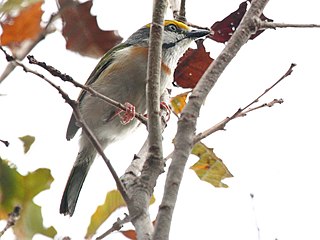
The chestnut-sided shrike-vireo is a species of bird in the family Vireonidae. It is found in Guatemala and Mexico. Its natural habitat is subtropical or tropical moist montane forests. With a length of 16.5 to 18 cm and a mean body mass of 34.7 g (1.22 oz), this is probably the largest species of vireo.

The green shrike-vireo is a species of bird in the family Vireonidae. It is found in Belize, Colombia, Costa Rica, El Salvador, Guatemala, Honduras, Mexico, Nicaragua, and Panama. Its natural habitat is subtropical or tropical moist lowland forests.

The clicking shrike-babbler is a species of bird in the family Vireonidae. It is found from Assam, India, eastern Myanmar to southern China, and southern Vietnam. Its natural habitats are subtropical or tropical moist lowland forests and subtropical or tropical moist montane forests. It used to be considered a subspecies of the chestnut-fronted shrike-babbler.




















